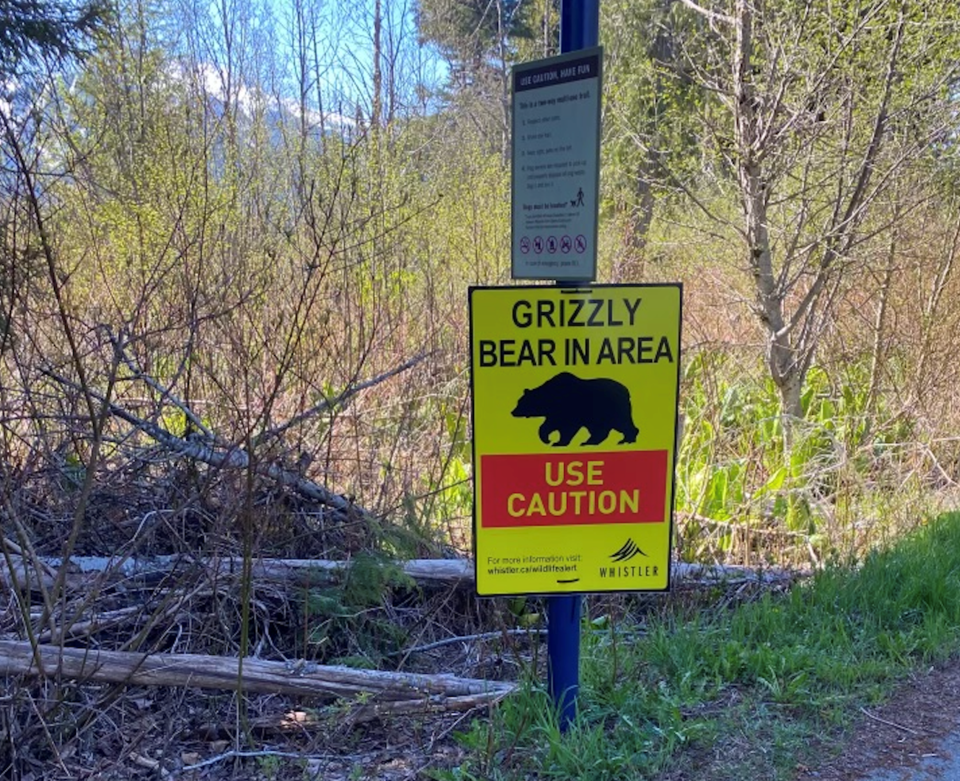In the late summer of 2023, you might have been forgiven if you thought grizzly bears were about to overrun the Resort Municipality of Whistler (RMOW).
That summer, grizzlies were spotted in local parks, on golf courses, and near elementary schools. They disrupted races, created excitement on social media, and led to more than a few signs posted on local trails.
But according to stats from the B.C. government, concerns of an impending grizzly bear uprising in Whistler were premature, at least as far as 2024 went.
In 2024, the BC Conservation Officer Service (COS) received 93 grizzly bear calls in the Sea to Sky zone, and 35 in Whistler—down from 125 and 73 the year prior, respectively.
A spokesperson with the provincial Ministry of Environment and Parks also noted sometimes grizzly bear calls turn out to be black bears (as was the case more than once in Whistler in 2023 and 2024).
“Whistler and the Sea to Sky region is considered bear country. Grizzly bears have been reoccupying their historic range and increasing their density following a period earlier in the last century where human/bear interactions often led to population decline,” reads a statement from the Ministry of Water, Land, and Resource Stewardship. “Recovery has been slowly but steadily occurring since the 1980s. Increased human presence in remote backcountry areas may also contribute to some of the reports to
the COS.”
Total Human/Wildlife Conflict Report (HWCR) calls were also way down in Whistler year over year, from 743 in 2023 to just 201 in 2024. For the Sea to Sky, HWCR calls dropped from 5,157 in 2023 to 4,187 in 2024.
None of this is to say grizzlies aren’t a going concern in the region.
In November 2024, two yearling grizzlies were shot on-reserve in Mount Currie by a member of the community, though specifics are still lacking. According to the BC Conservation Officer Service, an investigation into the incident is ongoing, with no updates to provide as of Jan. 6. No word on when we can expect to hear more, either.
In the meantime, the Coast to Cascades Grizzly Bear Initiative (C2C) is keeping a close eye on the local grizzly population, and will continue its work focusing on conflict reduction and grizzly recovery in the region in 2025—but as a non-government, non-profit organization, its initiatives are privately funded and dependent on fundraising, said communications coordinator Erica Van Loon.
“Our key initiatives going into 2025 include continuing our electric fencing cost-share program to help residents manage attractants, conducting small-scale DNA studies in local areas to improve our understanding of local populations (funding dependent), and advocating for habitat-based connectivity to support grizzly bear movement and recovery,” Van Loon said.
“We are actively seeking funding to continue our Conflict to Coexistence Project which includes public education initiatives and aversive conditioning work to reduce conflicts with grizzly bears, primarily in the Pemberton Meadows area. However, the size and reach of our initiatives are limited by funding constraints.”
Grizzlies in the Stein-Nahatlatch Population Unit are still considered “critically endangered,” while populations to the north and west are growing but remain classed as “threatened,” she added, noting exact population numbers are unknown.
“These bears rely on this critical habitat, and it’s essential for humans to take responsibility by managing attractants, using electric fencing, understanding bear behaviour and giving wildlife the space they need,” Van Loon said. “Grizzly bears will continue to move into Sea to Sky areas, including Pemberton, Whistler, Lil’wat, and Squamish, as recovery continues. Coexistence is critical and can be achieved with these proactive measures.”
The C2C team also sees a need for better government support to address conflicts quickly and effectively to prevent losses for both humans and bears, she added.
Time will tell what 2025 holds in terms of grizzly sightings in Whistler—but it seems officials would prefer to keep the spotlight off the issue as much as possible.
In early May, 2024, the RMOW posted signs notifying of a grizzly in the area around Meadow Park, urging the public to use caution—but didn’t directly notify media.
And in late July, the municipality closed part of its Alpine Trail Network after multiple grizzly sightings were reported in the area—again, without notifying media about the closure.
The COS also no longer communicates with media directly about wildlife conflicts, instead notifying the RMOW, which utilizes its own channels to get the information out at its discretion.
“If there is an urgent message to communicate, there will be boots-on-the-ground officers ensuring that gets done—COS and possibly RCMP,” an RMOW communications official told Pique in May.
“From our perspective, grizzlies will be part of our life in Whistler moving forward as long as we have a healthy ecosystem.”
That is no doubt true—but as is the case with all things, the public deserves more transparency and timely communication when it comes to grizzly bears in Whistler.
In its absence, we’re left with assumptions and best guesses—which are never the best bet when it comes to safety, whether human or wildlife.
Find more info at coasttocascades.org and whistler.ca/bears.




